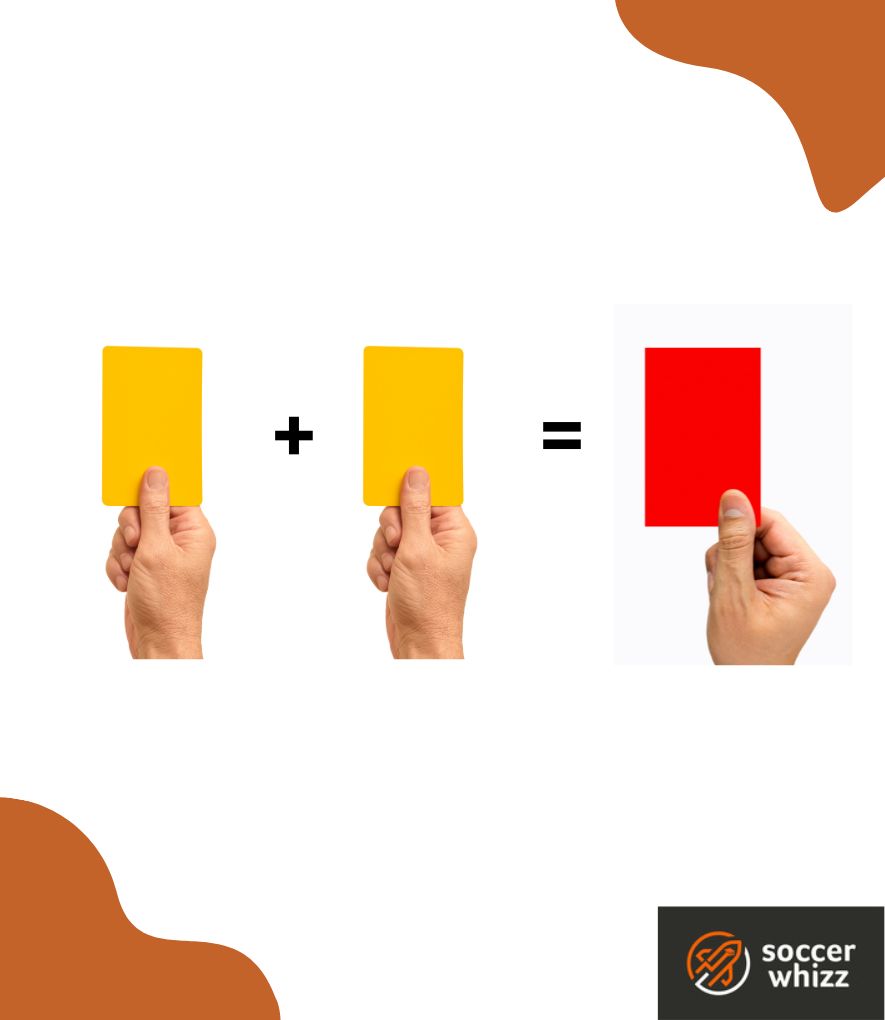Yellow cards are a familiar sight in the world of soccer, wielded by referees as a form of cautionary discipline.
As players engage in the fast-paced and intense nature of the game, infractions and fouls are bound to occur.
The yellow card, a vivid symbol of admonition, serves as a warning sign to players, indicating that their conduct or actions have crossed the line.
Essentially, the yellow card in soccer serves as an official caution to a player from a referee. The match official handing out the booking will write down the offender’s details in a small notebook, indicating the time and nature of the foul they committed.

In this article, we delve into the significance and implications of a yellow card in soccer, exploring its purpose, rules, and the consequences it carries for both players and teams.
- What happens if you get a yellow card in soccer?
- How many yellow cards can you get in a soccer game?
- What are the possible yellow card offences?
- How long does a yellow card last in soccer?
- Which players have received the most yellow cards in soccer history?
- What do referees write down on yellow cards?
- Can managers get yellow cards too?
- Concluding thoughts
What happens if you get a yellow card in soccer?
When a player receives a yellow card in soccer, it serves as a formal caution from the referee.
The yellow card is typically given for a variety of offenses, such as reckless challenges, unsporting behavior, time-wasting, or dissent.

Once a player is shown a yellow card, a few consequences come into play.
Firstly, the player’s name is recorded by the referee and the incident is documented.
If a player accumulates multiple yellow cards in a single match, they may face more severe disciplinary action, such as a red card and subsequent expulsion from the game.
In addition to the immediate impact, yellow cards also have implications beyond the match at hand.
Accumulating yellow cards over multiple games can result in further consequences.
In most competitions, if a player accumulates a certain number of yellow cards within a specific period, they may receive an automatic suspension for subsequent matches.
The exact number of yellow cards required for suspension varies depending on the league or competition’s rules.
How many yellow cards can you get in a soccer game?
During a soccer game, it’s entirely possible for a player to receive not just one, but two yellow cards.
This scenario unfolds when a player commits an offense that merits a yellow card and subsequently repeats another offense worthy of another caution.
As a result, a player can accumulate a total of two yellow cards in a single game before being issued a red card.

When a player receives two yellow cards in one game, the immediate consequence is a red card.
The red card signifies the player’s expulsion from the field, requiring them to leave promptly.
Additionally, the player will face a suspension, usually for at least one game, as a further punishment for their actions.
This system ensures that players are held accountable for repeated infractions and encourages fair play and sportsmanship on the field.
The prospect of receiving a red card after two yellow cards serves as a warning to players, emphasizing the importance of maintaining discipline and avoiding further transgressions.
What are the possible yellow card offences?
A player, substitute, or substituted player can find themselves receiving a yellow card for a total of six distinct offenses.
These offenses include:
- Delaying the restart of play – when a player intentionally stalls or hinders the resumption of the game.
- Dissent by word or action – displaying disagreement or disapproval towards the referee’s decisions through verbal or physical means.
- Unauthorized field entry or exit – entering, re-entering, or intentionally leaving the field without obtaining permission from the referee.
- Failure to respect the required distance – not maintaining the appropriate distance during restarts such as corner kicks, free kicks, or throw-ins, thus impeding the opposition’s ability to take the kick.
- Persistent offenses – consistently violating the Laws of the Game, even after receiving prior warnings or cautions from the referee.
- Unsporting behavior – engaging in conduct that is contrary to the spirit of fair play or sportsmanship.
Reference – FA Laws of the Game on Fouls and Misconduct
How long does a yellow card last in soccer?
Once a soccer player is cautioned and shown a yellow card by the referee, the consequences of that caution extend throughout the entirety of the game.
Regardless of whether the player receives the yellow card in the opening minutes or the dying moments of the match, they remain under caution until the final whistle.
It’ s also important to note that being shown two yellow cards leads to a red card, resulting in the player being expelled from the field.
This signifies that once a player has been cautioned with a yellow card, they are just one step away from facing a red card and being forced to leave the game prematurely.
Additionally, this added pressure of potential expulsion can have a detrimental impact on a player’s performance.
They may become more hesitant and cautious in their actions, potentially diminishing their effectiveness on the field.
However, once the game concludes, the caution is lifted, and the player starts the next game with a clean slate, free from any lingering yellow card.
The player’s disciplinary record resets, allowing them to approach the next match without any carryover consequences.
More so, there are instances when a yellow card’s impact extends beyond a single game.
In certain cases, a yellow card can carry over and remain in effect for the duration of a soccer season or competition, creating a more long-term impact on a player’s disciplinary status.
Which players have received the most yellow cards in soccer history?
Here are some examples of soccer players most notorious for picking up yellow cards during competitive matches:
1. Sergio Ramos
Ramos stands tall as the unrivaled frontrunner in the leaderboard, holding the remarkable record for the most yellow cards in the history of soccer.

As the former captain of Real Madrid, he amassed a staggering total of 269 yellow cards, surpassing all other players.
Additionally, Ramos faced the daunting prospect of being sent off 28 times during his club career alone.
It’s noteworthy that only two other players, who also had lengthy tenures in Spain, managed to accumulate over 200 bookings in this millennium.
Thus, Ramos stands out prominently as the player with the highest tally of yellow cards, cementing his reputation as a resilient and tenacious presence on the field.
2. Gerardo Torrado
Gerardo Torrado has earned the nickname “El Borrego” (“The Sheep”) due to his distinctively thick and voluminous hair.

Renowned for his robust playing style, he exhibited a tenacious presence on the field, excelling in ball recovery and showcasing impressive passing skills.
Torrado has amassed a whooping 228 yellow cards which is only second to Sergio Ramos.
3. Dani Alves
Alves – the player with the most accolades in soccer history – established himself as arguably the premier full-back of his era during his remarkable tenure in European soccer.

His illustrious career spanned prestigious clubs such as Barcelona, Juventus, and Paris Saint-Germain, where he amassed a treasure trove of significant achievements and major honors.
He garnered a considerable 135 yellow cards across his professional career.
What do referees write down on yellow cards?
When brandishing a yellow card, the referee meticulously notes three crucial details on it:
- The precise moment within the game when the offense took place.
- A concise description of the offense committed.
- The identity of the player responsible for the offense.
The act of recording this information serves as a fundamental tool for the referee, enabling them to maintain a comprehensive record of the events that unfolded during the match.
Can managers get yellow cards too?
During a soccer game, any team official, including managers and coaches, can find themselves being cautioned with a yellow card if they commit an offense.
This emphasizes that disciplinary measures are not exclusive to players on the field.
Furthermore, in cases where an offense occurs but the referee is unable to identify the specific offender, they have the authority to caution the most senior member of the coaching staff present.
This ensures accountability within the coaching staff and encourages responsible conduct throughout the game.
Concluding thoughts
Ultimately, the yellow card holds a significant role in the world of soccer, serving as a cautionary measure and a means of maintaining discipline on the field.
It’s a formal warning given by the referee to players who commit certain offenses, reminding them to adhere to the rules of the game and exhibit respectful conduct.
The yellow card remains in effect for the duration of the match, regardless of when it’s issued, and accumulating two yellow cards leads to a player being shown a red card and subsequently being sent off.
In the end, the yellow card serves as a visual reminder of the consequences of one’s actions and stands as a symbol of the importance of playing with respect, discipline, and a commitment to the spirit of the game.
If you’ve enjoyed the read, then you’ll also probably like the look of our related content pieces on what the blue card in soccer is supposed to represent and what a white card is in the context of soccer.
If you enjoy the content that I create and would like to buy me a coffee, then I’d really appreciate it!
Any money that I earn through this donation will be re-invested into more content for this website.
Additionally, by sending in a donation you’ll also receive a copy of my recently released 190+ page eBook on Soccer Ball Care, as well as be subscribed to our mailing list where you’ll be regularly informed on the latest developments concerning the Soccer Whizz blog.
- Future Icons: Europe’s Emerging Midfield Maestros Set for Glory - December 4, 2023
- Kickstarting a Revolution: How Soccer Transformed the United States Over the Last Four Years - October 7, 2023
- 4-1-4-1 Soccer Formation [Analysis] - September 23, 2023

